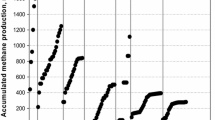Abstract
The study investigated methane production from dehydrated waste-activated sludge (DWAS) with approximately 80% water content under thermophilic conditions. The repeated batch-wise treatment of DWAS using methanogenic sludge unacclimated to high concentrations of ammonia, increased the ammonia production up to 7,600 mg N per kilogram total wet sludge of total ammonia concentration, and stopped the methane production. Investigation revealed that the loading ratio of DWAS for methanogenic sludge influences anaerobic digestion. Methane production significantly decreased and ammonia concentration increased with the increase in loading ratio of DWAS. Since the semicontinuous culture revealed that approximately 50% of organic nitrogen in DWAS converted to ammonia at sludge retention time (SRT) after 4 days at 37°C and 1.33 days at 55°C, the previous stripping of the ammonia produced from DWAS was carried out. The stripping of ammonia increased methane production significantly. This ammonia–methane two-stage anaerobic digestion demonstrated a successful methane production at SRT 20 days in the semicontinuous operation using a laboratory-scale reactor system.








Similar content being viewed by others
References
Bonmatí A, Flotats X (2003) Air stripping of ammonia from pig slurry: characterisation and feasibility as a pre- or post-treatment to mesophilic anaerobic digestion. Waste Manage (Oxford) 23:261–272
Fujishima S, Miyahara T, Noike T (2000) Effect of moisture content on anaerobic digestion of dewatered sludge: ammonia inhibition to carbohydrate removal and methane production. Water Sci Technol 41:119–127
Gunaseelan VN (1997) Anaerobic digestion of biomass for methane production: A review. Biomass Bioener 13:83–114
Hansen KH, Angelidaki I, Ahring BK (1999) Improving thermophilic anaerobic digestion of swine manure. Water Res 33:1805–1810
Hashimoto AG (1986) Ammonia inhibition of methanogenesis from cattle wastes. Agricultural Wastes 17:241–261
Held C, Wellacher M, Robra KH, Giibitz GM (2002) Two-stage anaerobic fermentation of organic waste in CSTR and UFAF-reactors. Biores Technol 81:19–24
Hendrinksen HV, Ahring BK (1991) Effects of ammonia on growth and morphology of thermophilic hydrogen-oxidizing methanogenic bacteria. FEMS Microbiol Ecol 85:241–246
Kayhanian M (1999) Ammonia inhibition in high-solids biogasification: an overview and practical solutions. Environ Technol 20:355–365
Koster IW, Lettinga G (1984) The influence of ammonium–nitrogen on the specific activity of pelletized methanogenic sludge. Agricultural Wastes 9:205–216
Koster IW, Lettinga G (1988) Anaerobic digestion at extreme ammonia concentrations. Biological Wastes 25:51–59
Lay J-J, Li Y, Noike T (1997) Influences of pH and moisture content on the methane production in high-solids sludge digestion. Water Res 31:1518–1152
Liao PH, Chen A, Lo KV (1995) Removal of nitrogen swine manure wastewaters by ammonia stripping. Biores Technol 54:17–20
Mata-Alvarez J, Macé S, Llabrés P (2000) Anaerobic digestion of organic solid wastes. An overview of research achievements and perspectives. Biores Technol 74:3–16
Parkin GF, Speece RE, Yang CHJ, Kocher WM (1983) Response of methane fermentation systems to industrial toxicants. J Water Pollut Control Fed 55:44–53
Robbins JE, Gerhardt SA, Kappel TJ (1989) Effects of total ammonia on anaerobic digestion and an example of digestor performance from cattle manure-protein mixtures. Biological Wastes 27:1–14
Rocher M, Goma G, Begue AP, Louvel L, Rols JL (1999) Toward a reduction in excess sludge production in activated sludge process. Appl Microbiol Biotechnol 51:883–890
Sosnowski P, Wieczorek A, Ledakowicz S (2003) Anaerobic co-digestion of sewage sludge and organic fraction of municipal solid wastes. Adv Environ Res 7:609–616
Sprott GD, Patel GB (1986) Ammonia toxicity in pure cultures of methanogenic bacteria. Sys Appl Microbiol 7:358–363
Sung SW, Liu T (2003) Ammonia inhibition on thermophilic anaerobic digestion. Chemosphere 53:43–52
van Velsen AFM (1979) Adaptation of methanogenic sludge to high ammonia–nitrogen concentrations. Water Res 13:995–999
Weemaes MPJ, Verstraete WH (1998) Evaluation of current wet sludge disintegration techniques. J Chem Technol Biotechnol 1998:83–92
Wei YS, Van Houten RT, Borger AR, Eikelboom DH, Fan YB (2003) Minimization of excess sludge production for biological wastewater treatment. Water Res 37:4453–4467
Acknowledgements
This investigation was supported by a grant from Hiroshima Prefectural Institute of Science and Technology.
Author information
Authors and Affiliations
Corresponding author
Rights and permissions
About this article
Cite this article
Nakashimada, Y., Ohshima, Y., Minami, H. et al. Ammonia–methane two-stage anaerobic digestion of dehydrated waste-activated sludge. Appl Microbiol Biotechnol 79, 1061–1069 (2008). https://doi.org/10.1007/s00253-008-1501-7
Received:
Revised:
Accepted:
Published:
Issue Date:
DOI: https://doi.org/10.1007/s00253-008-1501-7




